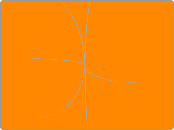Chemcial bonding
Ionic bonding
Ionic bonding is a type of electrostatic interaction between atoms which have a large electronegativity difference. There is no precise value that distinguishes ionic from covalent bonding, but a difference of electronegativity of over 1.7 is likely to be ionic, and a difference of less than 1.7 is likely to be covalent.[4] Ionic bonding leads to separate positive and negative ions. Ionic charges are commonly between −3e to +3e. Ionic bonding commonly occurs in metal salts such as sodium chloride (table salt). A typical feature of ionic bonds is that the species form into ionic crystals, in which no ion is specifically paired with any single other ion, in a specific directional bond. Rather, each species of ion is surrounded by ions of the opposite charge, and the spacing between it and each of the oppositely charged ions near it, is the same for all surrounding atoms of the same type. It is thus no longer possible to associate an ion with any specific other single ionized atom near it. This is a situation unlike that in covalent crystals, where covalent bonds between specific atoms are still discernible from the shorter distances between them, as measured by with such techniques as X-ray diffraction.
Bond formed between oppositely charged ions because of electrostatic forces of attraction.
Example: sodium + chlorine ----> sodium chloride
In the real world ionic compounds don't actually exist as ion-pairs which were formed from naturally occurring gaseous atoms. Instead, they exist as crystalline solids consisting of many ions, each cation being surrounded by anions and each anion being surrounding by cations to form a crystal lattice. Each cation-anion pair represents the release of energy.
Therefore, the reaction of the solid sodium atoms and the diatomic chlorine gas molecule to form the ionic solid sodium chloride can be broken down into 5 steps.
1.Vaporize the sodium atoms into gaseous sodium atoms. (use heat of vapaorization)
2.Dissociate the chlorine molecules into chlorine atoms. (use bond energy)
3.Ionize the sodium atoms. This is the oxidation step. (use ionization energy)
4.Add electron to chlorine atoms to form chloride ions. This is the reduction step. (use electron affinity) 5.Formation of the crystal lattice (use lattice energy)
6.The overall change in energy for the reaction
An ionic bond is a type of chemical bond formed through an electrostatic attraction between two oppositely charged ions. Ionic bonds are formed between a cation, which is usually a metal, and an anion, which is usually a nonmetal. Pure ionic bonding cannot exist: all ionic compounds have some degree of covalent bonding. Thus, an ionic bond is considered a bond where the ionic character is greater than the covalent character. The larger the difference in electronegativity between the two atoms involved in the bond, the more ionic (polar) the bond is. Bonds with partially ionic and partially covalent character are called polar covalent bonds. Ionic bonding is a form of noncovalent bonding.
Ionic compounds conduct electricity when molten or in solution, but not as a solid. They generally have a high melting point and tend to be soluble in water.
Covalent bonding
Covalent bonding is a common type of bonding, in which the electronegativity difference between the bonded atoms is small or nonexistent. Bonds within most organic compounds are described as covalent. See sigma bonds and pi bonds for LCAO-description of such bonding.
A polar covalent bond is a covalent bond with a significant ionic character. This means that the electrons are closer to one of the atoms than the other, creating an imbalance of charge. They occur as a bond between two atoms with moderately different electronegativities, and give rise to dipole-dipole interactions. The electronegativity of these bonds is 0.3 to 1.7
A coordinate covalent bond is one where both bonding electrons are from one of the atoms involved in the bond. These bonds give rise to Lewis acids and bases. The electrons are shared roughly equally between the atoms in contrast to ionic bonding. Such bonding occurs in molecules such as the ammonium ion (NH4+) and are shown by an arrow pointing to the Lewis acid. Also known as non-polar covalent bond, the electronegativity of these bonds range from 0 to 0.3.
Molecules which are formed primarily from non-polar covalent bonds are often immiscible in water or other polar solvents, but much more soluble in non-polar solvents such as hexane.
